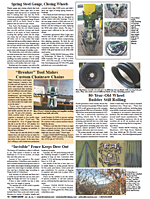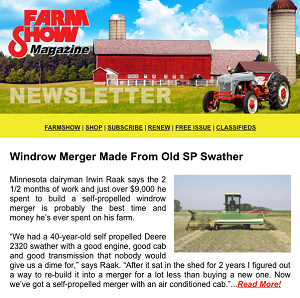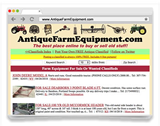2025 - Volume #49, Issue #1, Page #04
[ Sample Stories From This Issue | List of All Stories In This Issue | Print this story
| Read this issue]
Electric Combine Closer To Reality
Terry Krieg and Malcolm Lucas of Kangaroo Flat, Australia, combined their skills and expertise to build the world’s first electric combine.Krieg, with a power industry background, and Lucas, an innovative farmer-inventor, created and tested their prototype Linttas Electric Harvester over nine years.
Surprisingly, this working original was stolen from the farm in broad daylight. Fortunately, the pair were already developing a new and upgraded design based on their learned experience and observations.
“An electric combine is well overdue in the history of agricultural machines,” Krieg says. “Especially as it’s arguably the most complex machine on the farm.”
Since the earliest typical harvesters, Krieg says there’s been little or no concern for energy conservation or lowering the carbon footprint. “We’ve just made things bigger, adding more horses or mules, then larger engines, now over 1,000 hp. in some models.”
He explains that electricity saves energy and optimizes performance. Wasted energy consumption, including hydraulic pumps, belts, pulleys, chains and transport sections, is eliminated in the Linttas threshing process.
“Electric drives on each shaft, each with variable speed drives, help tune the threshing and grain separation process for optimal energy use and the highest performance,” Krieg says. “We achieve the tuning using sensors and machine learning algorithms.”
Grain separation can be precisely adjusted on the fly.
“Another big reason for electric is machine simplification and ease of repair,” he says. “From the outset, we considered the ‘right to repair.’ Because we only use off-the-shelf components and add self-diagnostics, plugs and sockets, the operator can diagnose and repair problems guided by the software diagnostics. An electric harvester is cheaper to purchase, repair, and easier to update when new technology comes along.”
Battery solutions are generally considered feasible for smaller agricultural machines (up to 100 hp.) but not for equipment as large as a combine on broad-acre farms. The Linttas Electric Harvester is hybrid-electric, using a single diesel engine running at optimal speed to drive an onboard generator and supply electrical energy.
“Since it’s always performing at optimal levels due to the machine learning (artificial intelligence) and an infinitely adjustable grain separation process, the engine is expected to last longer and use up to 30 percent less fuel than a traditional combine,” Krieg says.
Eventually, the pair hopes to upgrade the diesel engine, replacing it with a hydrogen-powered alternative when such engines and fuel distribution systems become readily available.
“Right now, we’re aiming at a lower carbon footprint for the life of our units. Our diesel-electric solution saves energy and is simple to operate and repair.”
Krieg and Lucas have patented the electric machine but have yet to start manufacturing it. They’re open to producing the combine with an industrial partner who supports their design concepts and aspirations.
The commercial production timeline depends on investment and collaboration. The pair are poised to enter an agreement with a research partner for the final concept simulation and modeling, which they estimate will take 12 months. They hope to use that modeling to optimize their design and develop the control algorithms before entering into a manufacturing agreement in 2026.
“We know what we’re developing will forever change how machinery is designed,” Krieg says. “We recognize the industry may see this technology as a threat to their business models, so we’re thrilled to get this to market but not by rushing headlong. We won’t partner with anyone who doesn’t share our ideals regarding sustainability and the ‘right to repair.’ This technology isn’t pie in the sky. We know it works based on nine years of real-world experience.”
Contact: FARM SHOW Followup, Linttas Electric Company (ph +61 (0)437 506 482; terry.krieg@linttas.com; www.linttas.com).

Click here to download page story appeared in.

Click here to read entire issue
To read the rest of this story, download this issue below or click here to register with your account number.



